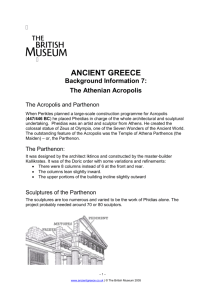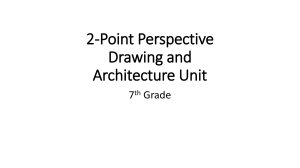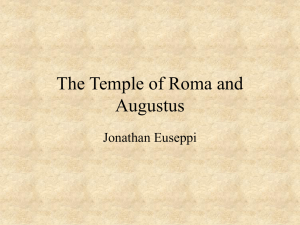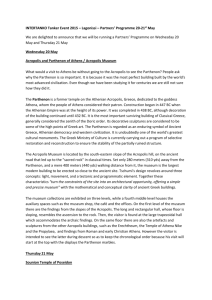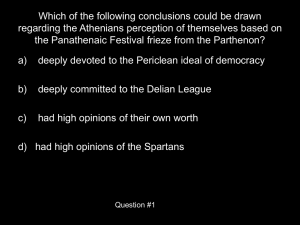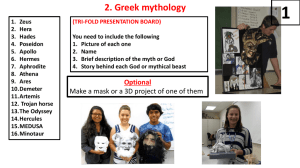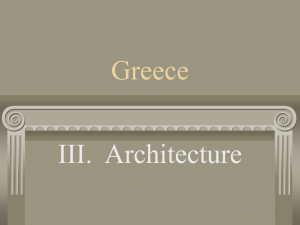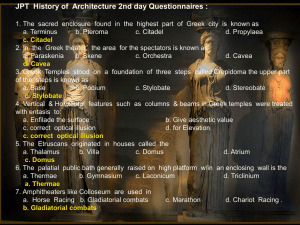perceptions of the greek temenos and temple
advertisement
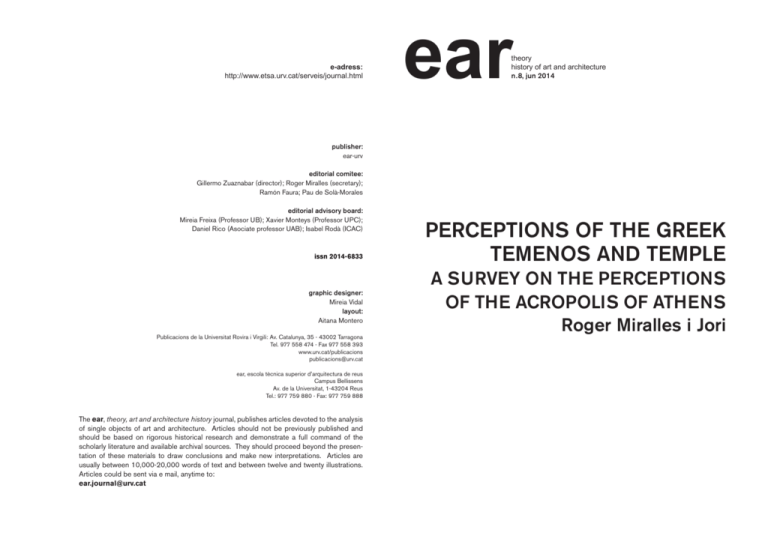
e-adress: http://www.etsa.urv.cat/serveis/journal.html ear theory history of art and architecture n.8, jun 2014 publisher: ear-urv editorial comitee: Gillermo Zuaznabar (director); Roger Miralles (secretary); Ramón Faura; Pau de Solà-Morales editorial advisory board: Mireia Freixa (Professor UB); Xavier Monteys (Professor UPC); Daniel Rico (Asociate professor UAB); Isabel Rodà (ICAC) issn 2014-6833 graphic designer: Mireia Vidal layout: Aitana Montero Publicacions de la Universitat Rovira i Virgili: Av. Catalunya, 35 - 43002 Tarragona Tel. 977 558 474 - Fax 977 558 393 www.urv.cat/publicacions publicacions@urv.cat ear, escola tècnica superior d’arquitectura de reus Campus Bellissens Av. de la Universitat, 1-43204 Reus Tel.: 977 759 880 - Fax: 977 759 888 The ear, theory, art and architecture history journal, publishes articles devoted to the analysis of single objects of art and architecture. Articles should not be previously published and should be based on rigorous historical research and demonstrate a full command of the scholarly literature and available archival sources. They should proceed beyond the presentation of these materials to draw conclusions and make new interpretations. Articles are usually between 10,000-20,000 words of text and between twelve and twenty illustrations. Articles could be sent via e mail, anytime to: ear.journal@urv.cat PERCEPTIONS OF THE GREEK TEMENOS AND TEMPLE A SURVEY ON THE PERCEPTIONS OF THE ACROPOLIS OF ATHENS Roger Miralles i Jori 4 ear n.8, june 2014 PERCEPTIONS OF THE GREEK TEMENOS AND TEMPLE 5 PERCEPTIONS OF THE GREEK TEMENOS AND TEMPLE KEYWORDS Architecture, Acropolis, Temple, Perception, Temenos. ABSTRACT This is an historical review of the way of seeing the Parthenon through the centuries. The different representations of the space give us the clue to understand how the Greeks thought the space of the Athenian Acropolis. The first presented drawings are of Cirac of Ancona, and then those from Jacques Carrey, Spon and Wehler, Pococke and Dalton. The great plans drawn in the XVIII century by Le Roy, Stuart and Revett are also commented. The XIX century is represented with the plans by Schinkel, Semper, Lange and the Penroses’ description. The XX century give us the clue with the descriptions of Doxiadis and Martienssen and we end with the XXI century’s new Acropolis museum by B. Tschumi. A SURVEY ON THE PERCEPTIONS OF THE ACROPOLIS OF ATHENS 6 ear n.8, june 2014 PERCEPTIONS OF THE GREEK TEMENOS AND TEMPLE fig. 1 Most scholars who deal with the subject of the temple and its setting want to know how it was planned but limit themselves to primary sources. Reference is made to ancient written testimony and the physical remains are examined. No reference is generally made to how the object has been interpreted over the course of time. Whoever looks at an object transforms it; as Baxandall explains, “each of us has had different experience, and so each of us has slightly different knowledge and skills of interpretation. Everyone, in fact, processes the data from the eye with different equipment”1. How one looks at something is therefore a product of one’s culture. This article sets out from the premise that representing an object is a way of explaining one’s perception of this object. Looking at how the same object is represented over time is the way to understand how it has been seen and, by putting all these views together, it is possible to construct a hypothesis as to how this object was conceived. The aim of this paper is to establish how the temple and its setting were planned in one specific case, that of the Acropolis of Athens, through the ways in which it was represented over time. Michael Baxandall, Painting and Experience Fifteenth Century Italy. A Primer in the Social History of Pictorial Style, 1972 Oxford University Press. 1 7 8 ear n.8, june 2014 Stuart & Revett PERCEPTIONS OF THE GREEK TEMENOS AND TEMPLE Ciriac d’Ancona fig. 2 After the Classical period, the first known representation of the Parthenon is that by Cyriacus of Ancona2 (c.1391-c.1455) , a papal diplomat and antiquarian. The original drawing by Cyriacus is part of a manuscript which contains various notes and commentaria3 . Seven copies of the manuscript exist, but only two (that located in Magdeburg and the one in the Vatican Library, made by Giuliano da Sangallo) include copies of the drawing. fig. 3 pediment does not represent what anybody can see today by looking at the Elgin Marbles. Neither the angles of the pediment nor the proportions of the peristyle or what is portrayed on it seem to matter. The author of the drawing does not notice these details, but draws a pediment on top of eight Doric columns without a base. The drawing by Cyriacus of Ancona (fig.1) appears to be a representation according to the system known today as dihedral: an elevation. This statement is based on the complete lack of perspective in the columns and the apparent absence of distortion (taking the representation of the figures as an indication) in the frieze. It might, however, be a representation from a frontal perspective as the steps on which the columns rest do seem to have a vanishing point, and the pediment may also have one, though there would then be the error of the lack of a central vanishing point for the columns. In this drawing, whether it is an elevation or a frontal perspective, we would not recognise the Parthenon. Our eyes have a different image of what the Parthenon of Athens is. Differences can be seen if this drawing is compared with Stuart and Revett’s4 elevation (the first which can be considered to be accurate in terms of its measurements and proportions). The pediment is sharper than that in the measured representation: it is changed from a 13º isosceles triangle to a 35º one. The peristyle is out of proportion: the ratio of the distance between the base and the architrave to the width is 10:3.5, while in Stuart and Revett’s representation it is 10:7 (fig.2). The The two copies of the drawing by Cyriacus of Ancona (fig.3) make clear what was important for the author or the person receiving the information. The two copies differ on many points but what they do have in common with one another and with the original drawing are actual features of the Parthenon. The important thing in these representations is not the proportions between the columns or the angle of the pediment; what the author is interested in is how the parts are put together. Any reader of the time would know what a metope, a column or a pediment was. The author of the drawing did not think he needed to describe these features precisely, but simply to indicate their presence and how they were put together. It is only the imagination of Giuliano da Sangallo – an architect – which allows him to add detail to something he is not familiar with because it is a copy of a less detailed drawing. The drawing becomes a narrative instrument to be read rather than an image which resembles reality. In this sense the representation by Cyriacus of Ancona is accurate as it places the signs in an order which can be transcribed in a real image. What he was interested in, essentially, was showing that Greek antiquity existed and that the buildings of that time were similar to Classical buildings in Italy . On Cyriacus of Ancona in general see E.W. Bodnar, Cyriacus of Ancona and Athens, Collections Latomus, XLIII (Brussels-Berchem, 1960). For the representations derived from Cyriacus of Ancona see Charles Mitchell, Ciriaco d’Ancona: Fifteenth-Century Drawings and Descriptions of the Parthenon 1973 in The Parthenon published by Vincent J. Bruno in the series Norton Critical Studies in Art History, 1974 W.W. Norton and Co. 1974 New York. (p.111-123). 3 Of Cyriacus of Ancona’s notebook the manuscript in which the drawing appears is preserved (it is currently kept at the Biblioteca Ambrosiana in Milan, in the Trotti section, MS.373). There are seven partial copies of Cyriacus’ manuscript, two of them with copies of the drawing; one is kept in Marburg, in the Westdeutsche Bibliotek, MS. Berol. Lat. Quart. 432 (previously Manzoni 92) fol 73r. The other copy, from a book of notes by Giuliano da Sangallo, is is kept in the Vatican library in Rome, Barberini MS. Lat 4424, fol 28v. 4 Stuart and Revett. The Antiquities of Athens. Measured and delineated by James Stuart R.R.S. and F.S.A. and Nicholas Revett painters and architects. London printed by John Haberkorn 1762. Plate 5, p.25 2 9 10 ear n.8, june 2014 PERCEPTIONS OF THE GREEK TEMENOS AND TEMPLE fig. 4 fig. 5 The second known representation of the Parthenon is that by Jaques Carrey5 from 1674 (fig.4). As he was unable to see the full scale of the building – due to the additions known to have been built on to it at the time – he concentrated on portraying the narrative which appeared on the friezes6. At no point did he make a drawing of the whole of the Parthenon. The artist was only interested in showing the narrative of the frieze, so he took no interest in the execution of the sculpture or in the colour. This is a representation by someone interested in sculpture as a narrative, not in the construction or the material properties of the object. The focus was on the cultural meaning of the building rather than on the building itself as a piece of architecture. The last known representation before the explosion of 1687 is by Jacob Spon in his Voyage d’Italie, de Dalmatie, de Grèce et du Levant, fait és années 1675-767 (fig.5). This was the first attempt to show the building as a volume. When we look at it we recognise some features: the number of columns is correct, there are eight on the shorter frontages and seventeen on the long ones, they are Doric in appearance and they have no base. Also recognisable is the entablature and a pediment decorated with sculpted motifs. Despite these matches, however, we still do not recognise the image of the Parthenon in this representation, the intercolumniation between the fourth and fifth column in the façade with the pediment is wider than that between the other columns to mark the entrance, there are five gigantic steps instead of three large ones (with a rise height of about 50 centimetres), the entablature is decorated with fantastic ornamentation instead of the triglyphs and metopes which would be more accurate. The portrayal of the sculpture on the pediment has very little to do with what we know today about the Parthenon. This representation appears to have been created in the studio rather than in front of the object it portrays. Certain features of the drawing support this statement; it is drawn with the aid of tools such as rulers and set squares, it is a fairly large drawing (120x105cm); it is a view which was impossible to see at the time because, as mentioned above, the Parthenon had various constructions built on to it. The author in the studio was working from memory. He was not setting down on paper what he had before his eyes, but what he remembered; Jacques Carrey, Temple de Minerve á Athènes, báti per Adrien (scratched over), Dessiné par ordre de Mr. Nointel Ambassadeur à la Porte. The collection of drawings is currently kept at the French national library. 6 Plates from 1 to 4 east and west friezes; plates from 5 to 8 metopes; plates from 9 to 14 interior frieze; plate 15 detail of the frieze; plate 22 detail of the corner; plate 23 detail of various sculptures; plate 24 overall view of various ruined buildings in Athens; plate 25 and 26 details of various buildings; plates 27 and 28 overall view of Athens from the Acropolis. 7 Jacob Spon in his Voyage d’Italie, de Dalmatie, de Grèce et du Levant fait aux aneés 1675-1676 par Jacob Spon Docteur Medicin aggregé par Lyon & George Wheler, Gentilhomme anglais, London, Printed for William Cademan, Robin Kettlewell, and Awnsham Churchill, at the Pope’s Head in the New Exchange, the Hand and Scepter in Fleetstreet , and the Black Swan near Amen Corner. MDCLXXXII. 5 11 12 ear n.8, june 2014 PERCEPTIONS OF THE GREEK TEMENOS AND TEMPLE fig. 7 fig. 8 fig. 6 from memory one draws what one has understood . If one knows a code one applies it when looking at things and the memory which remains, the image, is the memory of the application of the code. This is why looking at the picture painted by Magritte where the phrase “ceci n’est pas une pipe”8 appears is so surprising: we see something which in our linguistic code is a representation of an image but it has a caption which tells us that this is not what we are seeing. Something similar happens with the drawing by Spon; if one is only familiar with Roman architecture, when one sees a Greek temple one thinks of it as a clumsy Roman one. A peripteral temple in the hands of someone who has only studied Roman architecture is a mistake of composition as it does not highlight the main façades with a portico leaving the others with pilasters; a regular façade if there is a doorway is another error as one does not know which intercolumniation to enter through, and so on. Spon and Wheler probably did not even consider the possibility that the temple they saw was peripteral. At that time, being a church, the intercolumniations were filled in with walls which rose up to the top, so columns on the long sides were in fact seen as pilasters. Considering that the author was able to remove everything that stood around it to draw it as a solitary volume, he could also have taken out the walls from the sides and 8 The matter of the painting by Magritte is explained clearly in Berger, Ways of Seeing, Penguin Books, 1974, p.22 it must be presumed that if he did not do so it was because he thought that the building had in fact been deliberately constructed that way. The memory of Roman architecture, the way in which architecture was taught at that time, led the author, who had never seen either a peripteral temple or a Greek one, to approach the Parthenon as a Roman temple. This confusion was to persist for a long time. It is what is referred to as the Romanisation of Greek architecture. As proof of this Romanisation one could quote the title given to the bound collection of Carrey’s drawings which was made up in the 18th century, Temple de Minerve à Athènes, báti per Adrien. Whoever bound the drawings could not believe that anyone other than a Roman could have been responsible for such a major work. The temples of ancient Greece were seen as an older version of Roman temples, without any significant architectural differences. After the bombardment which destroyed much of the structure, the Parthenon continued to be portrayed as a temple with a Roman appearance, even though the representations were already starting to become more accurate. Pococke9 (1743) (fig.6) or Dalton10 (1751) (fig.7) were already drawing the temple as peripteral in its floor plan but the rest of their drawings did not take into account Richard Pococke, A Description of the East and Some other Countries, (London: printed for the author by W.Bowyer, 1743-45) vol. 2, pt.2, pl. LXVII, The temple of Minerva at Athens. 10 Richard Dalton (Edward Rooker copy ), A View of the Parthenion or Temple of Minerva at Athens, 1751, engraving. 9 13 14 ear n.8, june 2014 PERCEPTIONS OF THE GREEK TEMENOS AND TEMPLE fig. 9 fig. 10 the fact that it was peripteral. They only drew the elevation of the pediment, seeking the front of the building without realising that in a peripteral temple all the sides are of equal importance; they drew the shadows in the elevation of the pediment to highlight the depth the façade was given by this effect, but on the other hand they did not show the greater effect on the long sides due to the directions they faced in. The only thing which is emphasised in these representations is that there is a main façade and this is drawn axially. The axis is the form Romans had to build. The great Roman buildings were constructed on axes; baths or basilicas, with their great contribution to Roman architecture, were built on the logic of axes11 . An object seen from the axis appears as being flat, without volume, and approaching it along the axis does not change how one sees it, merely its size. Approaching an ancient temple along its axis, whether it is Greek or Roman makes little difference. Approaching a Greek temple from another angle is very different from approaching a Roman one, because all the effort of the Romans went into the façade which was approached on the axis, while in a Greek temple the architectural effort was spread all around the outside, making it difficult – if it were not for the altar – to know which side to stop at. Roman town planning forced one to approach temples along their axis, while the Greeks on the other hand allowed for various ways of approaching their temples. In this sense, while Roman architecture tended towards two dimensions, Greek architecture was in three dimensions. The work done in the 18th century on dissecting the Parthenon bore fruit in compilations of highly accurate drawings such as those to be found in the work by Roy, Les Ruines des plus beaux monuments de la Grèce and also in that by Stuart and Revett, Antiquities of Athens. Both works feature drawings not only of the Parthenon but of everything around it; in this way they appear to suggest that the Temple of Minerva formed part of an ensemble. Even so, this was still far from the idea of unity which was to prevail later on, as the fact that the buildings were seen among the other constructions which existed on the Acropolis prevented a view of the whole. In the section devoted to the Acropolis in his work Les Ruines des plus beaux monuments de la Grèce12, Julien-David Le Roy drew the Propylaea, the Erechtheum, the Parthenon, a view of the theatre and an overall plan of the site. He did not attempt to reconstruct the buildings in most of the drawings. The views (fig.8) he drew were scenes in which the ruins were combined with a cloudy sky more appropriate to Atlantic England than Mediterranean Greece. On the site plan the space of the Acropolis (fig.9) was shown surrounded by blocks of houses which, one must suppose, existed on the spot at that time. In his portrayal of the Parthenon one once again sees the Roman frontal orientation as only the elevation of the pediment and part of the side were shown. His portrayal of the Propylaea (fig.10) displayed an even clearer frontal orientation as the view of the reconstruction of the building was from an axial viewpoint. This statement is not mine, but is part of architectural historiography. E.g.: CHOISY, AUGUSTE, Historie de l’Architecture, tome premiere, Pub. Edouard Rouveyre, Paris. p.512 De l’art grec, qui semble un culte désintéressé rendu aux idées d’harmonie et de bauté abstraite, nous passóns à une architecture devient l’organe d’une autorité totute-puissante pour qui la construction des édifices publics est un moyen de domination. Les Romains batissent pour s’assimilier les nations soumises en les pliant aux moeurs de la servitude; l’architecture grecque se résume dans le temple, l’architecture romaine dans les thermes et les amphithéatres. 12 11 David Le Roy, Les Ruines des plus beaux monuments de la Grèce, considérées du cote de l’historie et du coté de l’architecture, 2d ed., 2 vol, Paris: Imprimerie de Louis-François Delatour, 1770. There is a modern version translated into English: David le Roy, The ruins of the most beautiful monuments of Greece, edited by Robin Middleton at Getty Research Institute, Los Angeles, 2004 15 16 ear n.8, june 2014 PERCEPTIONS OF THE GREEK TEMENOS AND TEMPLE fig. 11 fig. 12 Stuart and Revett, in their Antiquities of Athens, gave a much more accurate representation of what was on the Acropolis. Le Roy had made eight drawings whereas Stuart and Revett made forty-seven, plus those of the metopes and the frieze of the Panathenaea. The document testifies to the existence of the Propylaea, the Erechtheum, the Parthenon and the theatre and also included the cave and a plan showing the location of each. The plans are very precise. From these documents we can fintd out exactly what the buildings were like (except for the theatre, of which all we have is the plan) and they could probably even be reconstructed from these documents alone (fig.11). The reconstruction would, however, be incomplete if they had to be assigned to a location, if they had to placed on a specific spot. The site plan was less detailed (fig.12). It is impossible to know for sure what this document portrayed. It cannot be considered a reconstruction of its state in the past because there is no appreciable difference in height between the buildings, nor can it be presumed to be a survey of the existing state of the site as, according to Le Roy’s evidence or Stuart and Revett’s own views, the buildings were surrounded by other constructions. The plan is a portrayal of a constellation of constructions located on a flat plane without geographical features or other buildings which existed. The excuse of a lack of accuracy due to limited resources or the difficulty of working on the ground cannot apply here, because the representations of the buildings display a high degree of precision despite the difficulty of working from fragments in some cases. The Parthenon, for example, is shown highly accurately. The plan and the elevation of one side with a pediment are precise, and the other plans which would be necessary to complete the volume of the building were not made as they were not believed to be necessary to explain the construction; what is shown and judged to be necessary are many architectural details and nearly forty plates showing the sculptural groups on the friezes and metopes. The author who represented his subject in this way was interested not so much in presenting the building as in dissecting it: finding out exactly how the building was constructed in order to make up a catalogue of solutions which could be applied in constructing a new building, thus bringing the splendour of Classical Greece to any point in the British Empire. Stuart and Revett’s interest in each building on the Acropolis was individualised, and there was never an idea of the whole; they showed the resolution of the corner on every building, what the leaves on the Corinthian capitals were like and even how the folds were in the clothing of the caryatids with mathematical precision. This document with its precision and its potential for copying formed the basis of what became known as the Greek Revival13 among British architects, as J.Mordaunt Crook has established. J.Mourdaunt Crook, The Greek revival, Neo-Classical Attitudes in British Architecture 1760-1870, Pub. John Murray 1972 or the author himself in a more graphic version: J.Mourdaunt Crook, The Greek Revival, The RIBA Drawings Series, 1968. 13 17 18 ear n.8, june 2014 Le Roy, 1758 PERCEPTIONS OF THE GREEK TEMENOS AND TEMPLE Stuart & Revett, 1762 Dinsmoor, 1902 fig. 13 fig. 14 Stuart and Revett and Le Roy set out to make a useful, instrumental document for their contemporaries who were eager for information about ancient Greece. Producing such a document called for the precision at which Le Roy aimed in his plans and which Stuart and Revett consummated in all their details. What none of them did was to give an accurate view of the whole. If the two overall plans of the Acropolis are compared, one of them is wider than the other, and the angle between the buildings is not the same. The two representations are not portraying the same object. If one compares the two overall plans of the Acropolis, one sees that there was little interest in representing the ground on which the buildings stood as the differences are considerable. If a third plan (fig.13), Dinsmoor 190114 (which is today considered to be the accurate one) is added to the comparison, it becomes clear that the book with the most precise plans, Stuart and Revett, is the furthest from reality. They were not interested in the overall plan, and saw no need to reproduce the Greeks’ space; what was necessary for them was to reproduce the skin area of their buildings. the place. The first is that the architect copied Stuart and Revett’s site plan and therefore perpetuated the error in the proportions of the site, but maintained the accurate drawings of the constructions making up the ensemble. The second is that when an architect with Schinkel’s training looked at the site plan of the Acropolis by Stuart and Revett he could not help thinking that it was done less accurately than the other plates and corrected the error he saw with his own eyes: he drew the Propylaea and the Parthenon on parallel axes and not on axes with angles which were not parallel as depicted by the Englishmen and as can be seen in reality. The third, which is related to the first two and also to a lack of proper documentation to understand the Acropolis, is the following: the lack of a vertical section and the inaccuracy of the ground plan led Schinkel to draw the buildings on the same level. He does not recognise any difference in height between the Propylaea and the Parthenon or between the Parthenon and the Erechtheum; the space between the buildings is seen as superfluous, the difference in level as an accident. Anyone portraying the place like this has no desire to understand the whole, but still wants simply to exalt the beauty of some buildings which just happen to stand on that spot. Looking at this plan, how Schinkel understood the plan for Acropolis15 can be seen, along with how he digested Stuart and Revett’s plans and how he decided to proceed by filling up the gaps between the buildings without stopping to think that the space between them might have some importance. During the 19th century representations of the Acropolis of Athens did not take into account the proportions of the spot, systematically copying Stuart and Revett’s error. The most obvious example of this was the plan to convert the Acropolis into a royal palace, drawn up by the architect Karl Friedrich Schinkel (fig.14). Three aspects should be highlighted in view of today’s knowledge of Dinsmoor, William Bell, The architecture of ancient Greece and Rome, 1a Pub. 1901. The edition consulted was: Dinsmoor, William Bell, The architecture of ancient Greece and Rome, 3rd edition rev., B.T.Batsford, London 1950, p.197. 14 Schinkel’s plan can be seen in nearly all the monographs on him. Especially recommended is: Klaus Jan Philipp, Karl Freidrich Schinkel Späte Projecte Edition Axel Menges, Stuttgart/London, 2000 2 bande. Tafeln, in which the seven plates made by Schinkel are reproduced. It can also be found in various authors, 1781-1841 Schinkel, l’architetto del principe Albrizzi Editore, Cluva Libreria Editrice, 1982, Venice. P.162-164 15 19 20 ear n.8, june 2014 PERCEPTIONS OF THE GREEK TEMENOS AND TEMPLE fig. 15 fig. 16 The lack of attention to the place where so many important buildings stand began to change as the number of travellers coming to Athens to see them rose and the evidence that the ground was not level became undeniable. A terrain which supported the buildings on different levels needed to be taken into account. Thus, Semper16 included the terraces in his polychrome reconstruction of 1833 (fig.15), as did Lange in 1851 and many others after him. Even the book which replaced that by Stuart and Revett on many architecture offices with its drawings of the Acropolis, financed by the Académie Française17, made use of these terraces to support the different levels of the Acropolis. The view of the Acropolis featured in this book in the plates drawn by Lambert, is that of one who rationalises space (fig.16). Just as we know that the construction of a temple obeys certain laws, so does its site, the place where the building stands. The first requirement to be obeyed for a temple under this rationalisation of space is a flat surface with space around it allowing it be encircled without difficulties. It is in these drawings where a spatial hypothesis appears for the first time. It is not a space governed by axes, but a large base which makes the space occupied by a building autonomous from its neighbours. The space is not governed by axes, but by platforms on different levels on which the buildings stand; it appears that people have to move about between the platforms. This ground-breaking spatial hypothesis answers the question of how it was possible for the buildings situated on the Acropolis to have a space of their own but not the question of what relationship existed between them. Semper’s illustration of the polychrome reconstruction of the Parthenon is not included in all the monographs devoted mainly to him because they focus more on his buildings rather than on his critical writing. The bestillustrated book on the reconstruction is Harry Francis Mallgrave, Gottfried Semper, Architect of the Nineteenth Century, Yale University Press 1996, p. 48-51 17 D’Espoui, Fragments d’Architecture Antique d’après les relevés & restaurations des anciens pensionnaires de l’Académie de France a Rome publiés sous la direction de H. D’Espouy Professeur à l’Ècole des Beaux Arts. Paris, Librarie Générale de l’Arhitecture et des travaux publics, Charles Schmid, Éditeur, 51 rue des écoles. Paris. Seconde Section. Athènes. I. Acropole. Envoi de Lambert 1877. 18 Francis Cranmer Penrose, arch, M.A.F.R.A.S., An Investigation of the Principles of Athenian Architecture or The Results of a Survey Concluded Chiefly with Reference to the Optical Refinements Exhibited in the Construction of the Ancient Buildings at Athens. Published by The Society of Dilettanti. 1888, London and NYC, Macmillan and Co. p.104 16 On the other hand the 19th century, as well as raising the question of how the buildings were sited, saw the beginning of a concern for the optical refinements of Greek temples. Both polychrome (following Semper’s lead) and optical corrections were extensively studied. Regarding optical corrections, even though they are not the object of this paper, the observations made by Penrose should be highlighted: “In the Parthenon most of the principal dimensions are aliquot part of one another, the common measures being generally low numbers. With respect to the smaller dimensions, it is possible that the approximate sizes of the details were chosen, some to please the eye of the designer and others for constructive convenience”18. 21 22 ear n.8, june 2014 PERCEPTIONS OF THE GREEK TEMENOS AND TEMPLE Penrose’s appreciation of the Parthenon represents a duality which is wellknown in architecture, between aesthetic considerations and technical function. Up to then the appreciations in architectural historiography on the Parthenon were based on technique (explaining how it had been built or painted) of else on an exaltation of its beauty beyond the architect’s control; a beauty based on a romantic perception of architecture (which went beyond the buildings and the places and could even finish up talking about the gods) rather than an aesthetic one. His appreciation with regard to the architect is aesthetic. If a column has a height in relation to the intercolumniation and to its diameter, if the parts are numerically related to one another as Penrose says, how could this not happen on a spatial level? How could the buildings not be sited in positions in terms of ground plan and vertical section which relates them one to another? fig. 17 The Greeks and Egyptians’ space was defined by Giedion as an outdoor space. In his book The Eternal Present: The Beginnings of Architecture Giedion establishes three ages in terms of space: the first corresponds to the Egyptian and Greek period19 and exhibits a concern for outdoor space, the second covers a period running from the architecture of the Romans, through the Renaissance up to the 19th century, characterised by a preoccupation with outdoor space, and the third corresponds to Giedion’s own time (the 1920’s), showing an interest in both indoor and outdoor space. Rather than entering into a discussion of whether there is in fact any difference between outdoor and indoor space or whether it is all simply space, one with a roof and the other without, what Giedion does is to concentrate his gaze on the outdoor space between the temples, so that what becomes really relevant is the position of the buildings in relation to one another. Giedion, Sigfried, The Eternal Present: The Beginnings of Architecture, Pub. Boellingen foundation 1962, p.523. In this context, both the pyramids of Giza and the Acropolis at Athens express a similar relation to inner and outer space. Neither the Greeks nor the Egyptians ever developed interior space with the ame intensity they expended on relating their architecture to the cosmos. The first stage embraced both the archaic high civilizations and also the Greek development. Sculptural objects – volumes – were placed in limitless – outer – space. 19 23 24 ear n.8, june 2014 PERCEPTIONS OF THE GREEK TEMENOS AND TEMPLE In the 1930’s the need articulated in the previous century to find the way in which buildings were situated on the sacred site coexisted with the possibility of understanding the temple as a work created out of the visual relations between its parts and with Giedion’s assertion that the Greek space is basically outdoor space. Two works during the 30’s from very different parts of the world (South Africa and Germany) brought together all these concerns, and are the two most precise approximations to what the Greeks must have thought when planning the space for their sacred sites. In 1937 Doxiadis presented his Raumordnung im griechischen Staedtebau in Germany and in 1939 Martienssen read his phD The Idea of Space in Greek Architecture in South Africa. distribution of buildings on sacred sites followed polar coordinates based on the distance and the angle of vision one has, basically, from the Propylaea. “Für alle diese Beobachtungen ist vor besonderer Bedeutung der Eingang. Für alle die mathematischen Gesetze die bei diesen Anlagen angewendet sind, kann als Ausgangspunkt nicht das ganze Propylon gelten sonder ein bestimmer Punkt in ihm. Diese Punkt liegt, wie vollkommen natürlich ist und wie auch aus den untersuchten Beispielen hervorgeht, auf der mathematischen Achse des Propylon, und zwar dort, wo diese sich mit dessen Vorderkante schneidet. Praktisch ist dieser Punkt in der Mitte der Kante der obersten Stufe der nach der Anlage gerichteten Seite des Propylon“. The book by Doxiadis attempts to find a system in the placing of the temples within sacred sites (fig.17). Doxiadis was an architect whose main work was in town planning, either studying ancient models or planning new towns. His study of what the Greeks did served as a basis for his practical work, so his interest is essentially of a practical nature: he needs there to be a system which can then be applied by him. Doxiadis correctly asserted that, This is an attempt to make space scientific, to transform it into parameters which can be reduced to mathematical operations. A way of abstracting space to make it possible to reproduce this space in other circumstances. Trying to systematise the spatial properties and therefore the visual properties of Greek architecture is a task into which many variables come, and Doxiadis appears to reduce it to a drawing of a ground plan. Penrose, in the above-mentioned book, had already pointed out that the optical corrections of Greek architecture depended on each builder and could therefore not be generalised. Doxiadis, however, did so and did so in a convincing way, using algebra which was somewhat opaque for those not initiated in the field. A mathematician who was an expert in geometrical matters explained that his argument was not very accurate as it collapsed easily if the viewer is not at exactly the point from which the polar coordinates are traced; two metres to the left or right make the difference, so it cannot be seen as the system used by the Greeks to think about this issue. Nevertheless, the important thing is that Doxiadis aims to make us understand the space of the Greek sacred site through the eyes of the viewer. He brings the spectator, the visitor to the place, onto the scene. “Der Mensch aber, der in einer Landschaft steht und rings um sich sieht, fühlt die verschiedenen Gegenstände im Raum als in ein Koordinatensystem eingeordet, dessen Zentrum er selbst ist und in dem die verschiedenen Punkte in der Ebene durch eine Richtung und einen Abstand bestimmt sind. Dieses ist ein natürliches Koordinatensystem das vom Menschen abhänging ist, das der Mensch fühlt und überall anwendet. Es ist das System, welches wir heute PolarKoordinatensystem nennen”20. For him, space in ancient Greece is an abstract system of axial coordinates. Doxiadis analysed this natural system of coordinates and discovered that the Doxiadis, K, A, Raumordnung im griechischen städtebau Berlin : Kurt Vowinckel, Heidelberg-Berlin, 1937 (part of the series Beiträge zur Raumforschung und Raumordnung), p.10 20 25 26 ear n.8, june 2014 PERCEPTIONS OF THE GREEK TEMENOS AND TEMPLE fig. 18 Martienssen’s thesis devoted its fourth chapter, Temple and Temenos, to a discussion of the temple and its setting. He explained how the spectator perceived, on his ritual route to the altar, the different parts of the Greek sacred site. Doxiadis explained the view of the spectator from the Propylaea. Martienssen did this along the route, and whenever he believed there was a new impact for the spectator he described it (fig.18). There was no attempt to establish a scientific system governing the space; Martienssen’s intention was to explain the plastic properties of the space while a visitor moves through it following a prescribed route. The spatial properties are different in each temple, just as the setting around them is different. The site fits into its geographical location and each site highlights or displays part of the landscape surrounding it. The Acropolis of Athens cannot be reproduced anywhere else in the world because it is only here where the topography is like this, only on this spot that one has the distant views of the mountains, the proximity to the city and the Piraeus, and so on. Relief dictates what can be seen from the Acropolis, just as topography does. Martienssen explained that the height differences also form part of the distribution of the buildings, something which Doxiadis does not mention in his study. Martienssen described Greek temples in the belief that they are laid out on the basis of plastic resources, fitting into the topography and the setting of the sacred site. This came about in stages on these sacred sites. Martienssen described the Acropolis of Athens in a precise manner. Regarding the Propylaea he said that they were structures which set the scene for the spectator, preparing him for what was to come and giving him a frame of reference to confront something which would be very different to the space outside. This is a similar function to a closed gate, separating us from what lies behind us and giving us a pause before seeing what is behind it. Concerning the Propylaea of the Acropolis of Athens, Martienssen explained that, “Within the structure the usual system of two porticoes is found, but two rows of Ionic columns in the west portico continue to mark the width of the central opening as far as the wall which separates the two porticoes, and which in turn is pierced by five openings. The effect of this columned corridor within the portico is one of emphasis to the depth of the structure, and consequently of prolongation of the sense of transition in the spectator.”21 21 Rex Distin Martienssen, The Idea of Space in Greek Architecture. Witwatersrand University Press, 1952, p.105 27 28 ear n.8, june 2014 This description of the Propylaea uses perceptive arguments: depth – length – matters, and words deriving from the architectural style are only used to situate the spectator, and do not form part of the description. Martienssen’s description of the space of the Acropolis does not stop with the Propylaea, but moves on to the position of the statue of Athena Promachus behind the Erechtheum and a discussion of how the Parthenon can be seen to the south-east on a higher level. The route the spectator had to follow on festive days ran past the Propylaea, along the long façade to reach the east façade where, according to Martienssen’s sources, the altar would be found. He describes the route precisely, seeking not mathematical abstraction but an explanation of the plastic effect produced at each stage. Martienssen explains that when the spectator passes through the frame of reference, the Propylaea, they see the Parthenon from far enough away to be able both to understand it as a whole and to understand the volume. As the spectator approaches the building, the overall view is lost and one begins to see the building as a surface with depth, the side of the peripteral temple. In a close-up view the detail of the architectural features can be made out. Finally one reaches the altar and sees the eastern façade as a plane – the building has lost its volume – but the spectator is left not with this view but with the set of views they have had up to this point. It is at this point that the building is no longer of interest as the sacrifice of the animal at the altar now focuses the spectator’s attention. The Acropolis of Athens is a special case. It cannot, as Doxiadis thought, be extrapolated. What can be extrapolated is the method of study, understanding that the buildings were laid out according to plastic criteria rather than mathematical ones. Martienssen applies this method of analysing sites to five other temenos sites in his book. Especially illustrative of this way of understanding space as a route is his description of arriving at the Temple of Apollo at Delphi. PERCEPTIONS OF THE GREEK TEMENOS AND TEMPLE “Such a long sustained approach cannot do otherwise than induce in the spectator a mounting sense of climax, and it is in the arrangement at Delphi that one sees a parallel to the construction of the Greek tragedy. Both in architecture and drama the end is in sight, the spectator is familiar with all the elements that go to make up the particular unity to which they subscribe. He cannot influence the outcome of the plot in one case, nor can he modify the arrangement in the other –but in each he is subject to a form of compulsion that renders the end more vital and more moving than if the ‘suspense’ had been built up of elements of which he had no previous knowledge.” It is his introduction of the spectator as an active factor in the architecture which enables Martienssen to find the reason for the distribution of the constructions on the site. Martienssen is not applying a preconceived theory; there is no theory here, only a view. It is a question of shifting the stress to what happens to a visitor to the site and understanding that these plastic situations are not individual but can be generalised to all visitors. In Martienssen’s version, space in Greece was a concatenation of plastic situations with man at their centre. The Greek temple is a building to be seen from different viewpoints, unlike its Roman counterpart. Before writing his thesis, Martienssen had asserted in his notebook, “It will be sufficient to suggest that the three-dimensional values of architecture were lost sight of in the Rome of axial lines. Nowhere do we find a clearer demonstration of the difference between the Greek and Roman mind than in their architectural arrangements. The Roman passion for symmetry, for the axis, for order was the passion of conquest, the ruthless discipline of the military camp. The Greeks, possessed of a tactile sense which was never given to the Romans, poised their buildings instinctively and with unerring rightness.”22 Rex Distin Martienssen, Note in a notebook kept in the box Greek Studies in the Martienssen Archive, Witwatersrand University, Johannesburg. 22 29 30 ear n.8, june 2014 The distinction between one culture and another is fundamental to understanding their concept of space. The Romans were interested in conquering the world and therefore systematised territory. The Greeks on the other hand were humanists and placed their constructions according to what men perceived. The objection could be raised of the Greek’s systematisation of territory when they built towns, the prototypical example being the grid layout of Miletus. The grid of streets produced a kind of lack of differentiation of space until one reached a public space or one’s home. The streets can be understood on a perceptual level as an antechamber before what really mattered: the street was just preparation for the architecture of the public space or home. The lack of differentiation of the street space served to make one appreciate the domestic or the civic space. Martienssen’s thesis was that only by placing man at the centre of the project can the architecture of the Greeks be understood. One of the most recent known representations of the Acropolis of Athens is the project by Bernard Tschumi to build a museum for the Acropolis (fig.19)23. The project plan sets out to re-create the Parthenon. Its ground plan has the same dimensions, it is the same height and it lies in the same direction. It uses different materials to express the passage of time but it cannot be perceived as the Parthenon was designed to be perceived. Its different position makes the setting completely different, so it is impossible to see it in the same way as the Parthenon, but the most important thing is that the only perception one can have of the proportions of the rectangle of the Parthenon is from the air or when one is inside it, as it is on a level which is not visible from the ground. The interior of the temple was a space never explored by ordinary Greeks and did not belong to them, and moreover it is seen along the axis, contrary to what Martienssen had concluded. Documentation on the building can be seen in different places, in particular in the complete work, B. Tschumi, Event-Cities 3 concept vs. context vs. content, 2004 The MIT Press, Cambridge, Massachusetts and London, England. In chapter D. Conceptualizing Context, Athens, New Acropolis Museum, 200-: Paradoxes, Paraboxes p.428-477 or on the internet at http://www.arcspace.com/architects/Tschumi/. 23 PERCEPTIONS OF THE GREEK TEMENOS AND TEMPLE fig. 19 This representation does not seek to explain the space of the Greek temple, but only to show its volume, in the same way as Cyriacus only wanted to recognise the parts of which it was made up, Carrey sought to reveal its semantic meaning in the metopes, Stuart and Revett wanted to make a catalogue of details and Doxiadis wanted to reveal a hidden science. The only representation which reasonably explains the space of the Acropolis of Athens is the one that situates man at the centre of the narrative, constructed using plastic means and not attempting to apply formulas derived from other architectures. Martienssen provides the only reasonable explanation in historical and aesthetic terms of how the space around temples was conceived on sacred sites. 31 32 ear n.8, june 2014 PERCEPTIONS OF THE GREEK TEMENOS AND TEMPLE 33 PERCEPTIONS OF THE GREEK TEMENOS AND TEMPLE A SURVEY ON THE PERCEPTIONS OF THE ACROPOLIS OF ATHENS Roger Miralles i Jori Roger Miralles i Jori (Barcelona, 1974) holds a professional degree in Architecture from the ETSA of Universitat Politècnica de Catalunya and a PhD in Design Projects from the UPC (‘The Idea of Space in Martienssen’s Architecture. The Greenside House.’ phD 2012). Currently ETSA lecturer at the Universitat Rovira i Virgili, and previously has lectured at IED Barcelona, ETSA La Salle and the University of the Witwatersrand. He is author of: Five pictures by Rex Martienssen, March 1938 (Massilia 2006); Martienssen-Le Corbusier, classical relations, (Massilia 2008); Towards a definition of Architecture via Martienssen’s South Africa (Diagonal, 2013); How can I look to a Temple from modernity? ([i2] 2014); Dialogue between Martienssen and Le Corbusier (Dearq 2014).
